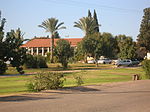Ma'ayan Harod (Hebrew: מעיין חרוד, lit. 'Harod's spring') or Ain Jalut (Arabic: عين جالوت ‘ayn Jālūt, or عين جالود ‘ayn Jālūd, and Hebrew: גילות, romanized: ain djeluth) is an all-year spring in the Jezreel Valley on the northwest corner of Mount Gilboa that was the location of the 13th-century Battle of Ain Jalut. This was a major turning point in world history that saw the Mamluks inflict the first of two defeats on the Mongols that ultimately halted their invasion of the Levant and Egypt.The traditional name of Ain Jalut has been in use since the 12th century, and is commonly believed to mean "Spring of Goliath", although alternative etymologies have suggested that it might be derived from the name Gilead, potentially an archaic name for Mount Gilboa. Other names given to the site include "En Harod" or "Ein Harod", a biblical place name that was associated with Ain Jalut in the 19th century, though subsequent scholarship, specifically the work of Israel Finkelstein and Oded Lipschits, has refuted this connection. Other associations have also been suggested, including in the 1841 Biblical Researches in Palestine, which linked it to the "spring in Jezreel" where Saul pitched his tent before his final battle, but this was rejected in 1847 and has gained little traction since. The spring is still sometimes known as the "Fountain of Jezreel", as well as "Gideon's Fountain".According to the medieval chronicler Baha ad-Din ibn Shaddad there was a prosperous village at the site in the Middle Ages. It was captured by the Crusaders and retaken by Saladin in 579. A later Palestinian village was also established in the area in the late 19th century. In the 1920s, the Zionist activist Yehoshua Hankin purchased the surrounding area as part of the Sursock Purchases through the Palestine Land Development Company, and founded a kibbutz, which he called Ein Harod, near the spring. The site is today incorporated into the Ma'ayan Harod National Park, administered by the Israel Nature and Parks Authority.









